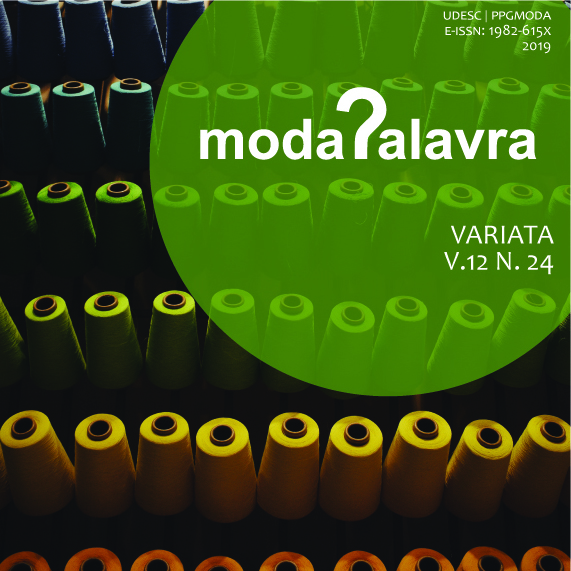O Inframince: A Potencialidade De Um Campo Relacional
DOI:
https://doi.org/10.5965/1982615x12242019056Palavras-chave:
design, criação, arte, percepção sensívelResumo
A noção de inframince de Marcel Duchamp fornece um vasto campo de pesquisa. É um terreno fértil para proposições sobre uma estética, uma poética e uma política no campo do design e da arte contemporâneas. Duchamp descreve o inframince enquanto uma qualidade do sensível que se encontra no entre, e é um campo relacional pleno de possibilidades. A experiência sensível reorganiza a existência criando percepções singulares. Este estudo apresenta uma articulação entre a noção de inframince e alguns projetos de design.
Downloads
Referências
“O Infra-mince é um enunciado de Marcel Duchamp sobre um conjunto de notas evocando aspectos sensoriais e envolvendo percepções da ordem do sensível, da sensação, da linguagem e da complexidade dos jogos de palavra” (Franca-Huchet, 2015, p. 41)
"Na verdade, a observação do campo das “pequenas percepções” ampliava os acontecimentos da maneira surpreendente: convertendo as micro em macropercepções como uma lente, a percepção do objeto modificava-se ao ponto de exigir uma descrição diferente. Da mesma forma que Fernando Pessoa aumentando a escala das “sensações mínimas”, se dava os instrumentos necessários à análise e à elaboração da expressão poética, assim o pintor, o músico, o escultor trabalham constantemente com pequenas percepções". (Gil, 2005, p. 11)
"A arte não consiste mais, aqui, em compor uma ‘mensagem’, mas em maquinar um dispositivo que permita à parte ainda muda da criatividade cósmica fazer ouvir seu próprio canto. Um novo tipo de artista aparece, que não conta mais história. É um arquiteto de espaço dos acontecimentos, um engenheiro de mundos para bilhões de histórias por vir. Ele esculpe o virtual". (Lévy, 2001, p. 147)
"Nota 6 – A alegoria (geralmente) é uma aplicação do infra-mince
Nota 7 – Similitude / similaridade
O mesmo (fabricado em série)
aproximação prática da similaridade
No tempo um mesmo objeto não é o mesmo em 1 segundo de intervalo
Qual relação com o princípio de identidade?
Nota 18 – A diferença (dimensional) entre 2 objetos feitos em série [saídos do mesmo molde] é um infra mince quando o máximo (?) de precisão é obtido". (Duchamp, 1999)
FRANCA-HUCHET, Patrícia. Infra-mince ou um murmúrio secreto. Art Research Journal. ARJ. Brasil: V. 2, n. 2 , p. 40-59 , jul. / dez. 2015. Disponível em:
http://www.periodicos.ufrn.br/artresearchjournal/article/download/7297/5737 Acesso em 20/03/2014.
GIL, José. A imagem nua e as pequenas percepções. 2a edição. Lisboa: Relógio D’Água, 2005.
LÉVY, Pierre. O que é o virtual. Rio de Janeiro: Editora 34, 2001.
DUCHAMP, Marcel. Notes. Paris: Flammarion, 1999.
Downloads
Publicado
Como Citar
Edição
Seção
Licença
Copyright (c) 2019 Leila Reinert

Este trabalho está licenciado sob uma licença Creative Commons Attribution-NonCommercial 4.0 International License.
Ao submeter um artigo para publicação no ModaPalavra e-periódico, o(s) autor(es) concorda(m) com os seguintes termos:
- Autores mantêm os direitos autorais e concedem à revista o direito de primeira publicação, com o trabalho simultaneamente licenciado sob a Creative Commons Atribuição-NãoComercial 4.0 Internacional, que permite o compartilhamento do trabalho com reconhecimento da autoria e publicação inicial nesta revista, sem pagamento;
- Os autores podem utilizar os mesmos resultados em outra publicações após a primeira publicação, desde que indiquem o ModaPalavra e-periódico como o meio de publicação original;
- Autores têm autorização para assumir contratos adicionais separadamente somente após a publicacão inicial no ModaPalavra e-periódico, desde que indiquem o ModaPalavra e-periódico como o meio de publicação original;
- Autores têm permissão e são estimulados a publicar e distribuir seu trabalho on-line (ex.: em repositórios institucionais ou na sua página pessoal), somente após o processo editorial e primeira publicação, desde que indiquem o ModaPalavra e-periódico como o meio de publicação original;
- Para indicar o ModaPalavra e-periódico como o meio de publicação original, o autor deve seguir texto modelo: "Este artigo foi publicado originalmente pelo ModaPalavra e-periódico, sob a licença CC BY NC, em seu volume [inserir volume], número [inserir número] no ano de [inserir ano], e pode ser acessado em: http://www.revistas.udesc.br/index.php/modapalavra/";
- As opiniões expressas nos artigos são de inteira responsabilidade dos autores, não refletindo necessariamente a opinião da revista. A publicação de artigos, fotos e desenhos foi autorizada previamente pelos responsáveis ou seus representantes para publicação no ModaPalavra e-periódico.









